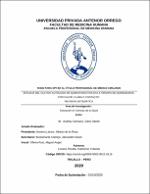| dc.contributor.advisor | Lozano Peralta, Katherine Yolanda | |
| dc.contributor.author | Ucañay Carrasco, Dany Daniel | |
| dc.creator | Ucañay Carrasco, Dany Daniel | |
| dc.date.accessioned | 2021-06-01T00:51:05Z | |
| dc.date.available | 2021-06-01T00:51:05Z | |
| dc.date.issued | 2021 | |
| dc.identifier.uri | https://hdl.handle.net/20.500.12759/7613 | |
| dc.description.abstract | Comparar la eficacia del Cultivo Autólogo de Queratinocitos frente a otros
manejos en el tratamiento de Quemaduras.
Materiales y Métodos: Se hizo esta Revisión Sistemática utilizando Ovid Cochrane
Library, EBSCO y PubMed. Los investigadores, independientemente realizaron la
seleccionaron publicaciones científicas, valoración de riesgo de sesgo y extrapolación
de datos. La eficacia se basó en la calidad de la Cicatrización, medida por Escala
POSAS para Observador y Paciente, el Índice de Eritema y Melanina, y la Elasticidad
de la Piel.
Resultados: Se revisaron 2169 estudios en título y resumen, cuatro en texto completo
y seleccionamos uno para análisis cualitativo. El cierre de heridas fue tras 5-7 días, se
evaluó la calidad de la cicatriz por Puntuación de Cicatriz (POSAS), color de Piel
(DermaSpectrometer®) y elasticidad (Cutometer®). La epitelización fue mejor para
Células Epiteliales Autólogas Cultivadas - CEAC (71%) comparado con la Tratamiento
Estándar – Trasplante con Autoinjerto de Piel Dividida en Malla - SSG (67%) (p=0.034,
Wilcoxon). La calidad de la cicatriz se evaluó a los 3 y 12 meses siendo mejores en
CEAC; hubieron mejoras entre el 12 y 33% (p≤0.010, Wilcoxon) para enrojecimiento,
pigmentación, grosor, alivio y flexibilidad. El índice de Melanina y Eritema a los 12
meses estuvieron más cerca de la piel normal para el CEAC que para SSG (p≤0.025,
t-Student pareado). La elasticidad fue mayor (p=0.030) en CEAC a los 3 meses de
seguimiento.4
Conclusiones: CEAC (Cultivo Autólogo de Células Epiteliales: Queratinocitos y
Melanocitos, combinado con SSG) tiene mayor eficacia en Cicatrización, Eritema,
Melanina y Elasticidad, comparado al SSG (Trasplante con tejido autólogo de piel
dividida en malla) en el manejo terapéutico de pacientes con quemaduras. | es_PE |
| dc.description.abstract | To compare the efficacy of Autologous Keratinocyte Culture against other
treatments in the treatment of Burns
Materials and methods: A Systematic Review of Clinical Trials was made using the
Ovid Cochrane Library, EBSCO and PubMed. The independent researchers carried
out the selection of scientific articles, assessment of risk of bias and data extraction.
The efficacy result was based on the quality of the Healing, measured by the POSAS
Scale for Observer and Patient, the Erythema and Melanin Index, and the Skin
Elasticity.
Results: 2169 studies were reviewed in Title and abstract, 4 in Full text and one was
selected for qualitative analysis. Wound closure was after 5-7 days, the quality of the
scar was evaluated by Scar Score (POSAS), Skin color (DermaSpectrometer®) and
elasticity (Cutometer®). Epithelialization was better for Autologous Cultured Epithelial
Cells - CEAC (71%) compared to the Standard Treatment - Meshed Split Skin
Autograft Transplantation - SSG (67%) (p = 0.034, Wilcoxon). The quality of the scar
was evaluated at 3 and 12 months, being better in CEAC; There were improvements
between 12 and 33% (p≤0.010, Wilcoxon) for redness, pigmentation, thickness, relief
and flexibility. The Melanin and Erythema index at 12 months were closer to normal
skin for CEAC than for SSG (p≤0.025, paired t-Student). The elasticity was greater (p
= 0.030) in CEAC at 3 months of follow-up.6
Conclusions: CEAC (Autologous Epithelial Cell Culture: Keratinocytes and
Melanocytes, combined with SSG) has greater efficacy in Scarring, Erythema, Melanin
and Elasticity, compared to SSG (Transplantation with autologous tissue divided into
mesh) in the therapeutic management of patients with burns. | en_US |
| dc.description.uri | Tesis | es_PE |
| dc.format | application/pdf | es_PE |
| dc.language.iso | spa | es_PE |
| dc.publisher | Universidad Privada Antenor Orrego | es_PE |
| dc.relation.ispartofseries | T_MED_3050 | |
| dc.rights | info:eu-repo/semantics/openAccess | es_PE |
| dc.rights.uri | https://creativecommons.org/licenses/by/4.0/ | es_PE |
| dc.source | Universidad Privada Antenor Orrego | es_PE |
| dc.source | Repositorio Institucional - UPAO | es_PE |
| dc.subject | Cicatrización | es_PE |
| dc.subject | Quemaduras | es_PE |
| dc.title | Eficacia del cultivo autólogo de queratinocitos en la terapia de quemaduras, por calor, flama o contacto: revisión sistemática | es_PE |
| dc.type | info:eu-repo/semantics/bachelorThesis | es_PE |
| thesis.degree.level | Título Profesional | es_PE |
| thesis.degree.grantor | Universidad Privada Antenor Orrego. Facultad de Medicina Humana | es_PE |
| thesis.degree.name | Médico Cirujano | es_PE |
| thesis.degree.discipline | Medicina Humana | es_PE |
| dc.subject.ocde | https://purl.org/pe-repo/ocde/ford#3.02.27 | es_PE |
| renati.advisor.orcid | https://orcid.org/0000-0002-9011-6116 | es_PE |
| renati.author.dni | 47651587 | |
| renati.advisor.dni | 40012490 | |
| renati.type | https://purl.org/pe-repo/renati/type#tesis | es_PE |
| renati.level | https://purl.org/pe-repo/renati/level#tituloProfesional | es_PE |
| renati.discipline | 912016 | es_PE |
| renati.juror | Moreno Lázaro, Alberto de la Rosa | |
| renati.juror | Bustamante Cabrejo, Alexander David | |
| renati.juror | Villena Ruiz, Miguel Ángel | |
| dc.publisher.country | PE | es_PE |


